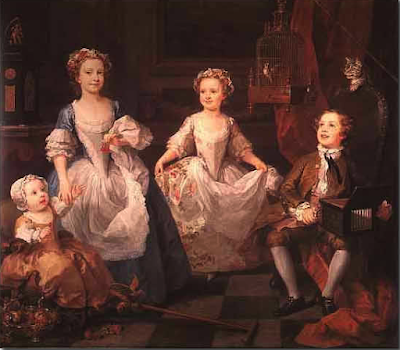Image credit Sir John Soane's Museum, The Rake Taking Possession of his Estate, William Hogarth, oil on canvas, 1734, 25" x 30", held by Sir John Soane's Museum, London.
Which brings me to Bugler's analysis:
"The Rake's Progress," a series of eight paintings by Hogarth, traces the story of Tom Rakewell, who inherits a fortune from his miserly father only to squander it in an orgy of vice that leads to his final decline into poverty and madness....A starving cat is searching an open chest for food, but finds only silverware--a comic indication, perhaps, of how useless all Tom's new wealth will prove to be to him in the end.
So we'd better check out the close-up of the poor kitty:
Now that is one sorry pussycat. I've often thought that the way in which people treat animals is perhaps the best indicator of their real character.
Hogarth didn't only paint gloomy images; just check out this cheery painting (The Graham Children) that I featured here at Cats in Art about 5 years ago:
Looking forward to a great 2017!
[Gary note: With my Cats in Arts posts, I encourage you to scope out the art appreciation site Artsy (I have no financial interest in the site, I just like it), where you can explore many aspects of the world of art. You'll certainly be entertained and enlightened!]



In my opinion this is one of the best representations of a cat in traditional western art. You can almost hear the sound that cat is making as the eyes the caged bird. Additionally, the cat seems to represent us as we admire the beauty of the children, as lovely as that bird, who are caged in their finery and displayed for the status of the family to admiring viewers.
ReplyDelete